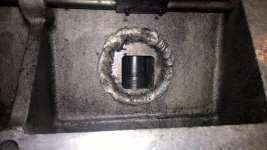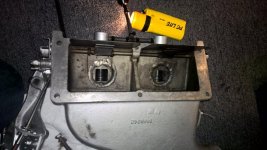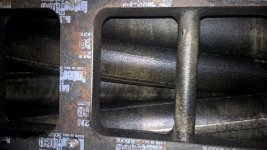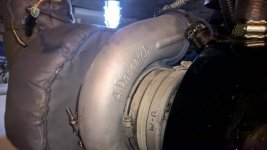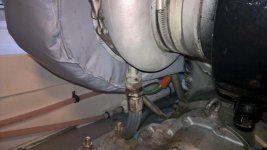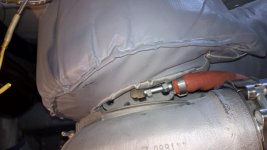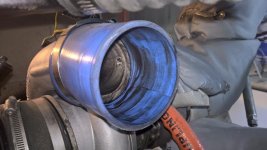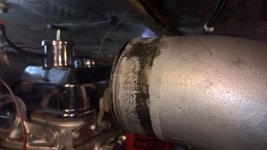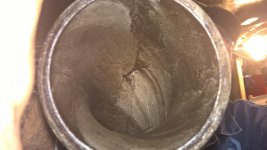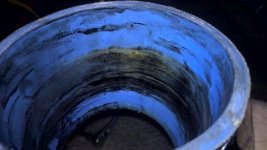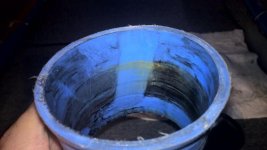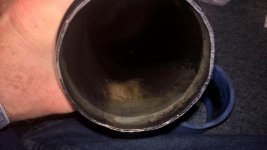Here's a little something about turbos you WON'T find in the book. And...I don't know why! It is VERY important but they never emphasize this stuff. As if we are all BORN with the knowledge!
A turbo is EXTREMELY powerful. We always used turbo GUARDS placed over the inlet of the compressor wheel if we needed to run the engine with the inlet ducting off. The reason is not only to keep foreign objects like rags or tools from entering and damaging the turbo but, more importantly, to keep YOU out! I once reached for a hammer that I had left on top of the 6V92TA I was working on while the engine was IDLING. I picked up the hammer and started to bring my arm and hand back in front of the turbo intake. I never made it! The suction from the turbo grabbed my hand and slammed it, WITH the hammer still clenched in my fist, right up against that screen! Had that screen cover not been in place, it would have been a VERY bad day for me and I would be typing this missive ONE HANDED. I REPEAT...That's the power of a turbo at IDLE!
Until that happened, I never FULLY realized just how powerful the turbochargers are. I gained a whole new respect and understanding of just what it is they are capable of.
When you are in the throttle and turning the engine at up around 1800 rpm and making in the high 20's boost, the turbo wheels can be turning in excess of 100,000 rpm. Think about that! 100,000 rpm! What else do you know of that turns that fast? I can't think of very many right off the top of my head. And, it's because that is DAMN fast!
Now, think about that some more and look at the oil feed line in your #6 pic you uploaded. That line and what it should be carrying is ALL that keeps that turbo from flying apart at those speeds! Many people that own turbocharged engines are not aware that, because of the rpms these things do, that they REQUIRE cleaner...fresher oil than a normally aspirated engine. The turbo CANNOT survive on dirty, broken down oil. The lack of timely oil changes that an engine can easily withstand, will kill a turbo shaft bearing set pretty quickly. They HAVE TO HAVE a STEADY, CLEAN supply of top grade oil AT ALL TIMES. That means that that feed line in pic 6 is CRUCIAL.
And, we go to picture #5 and we see the bearing oil drain line. That needs to be kept clear so that oil can easily drain back from the bearing to the crankcase. I have seen them get clogged with pieces of gasket material... and silicone...and parts of shop rags. If that line clogs, the oil can't flow past the bearing as is desirable and will actually look like a loss of lube failure when analyzed.
As far a checking the turbo for passing oil at the compressor wheel, just refer to your picture #1. You just need to remove the blue silicone hose, held on with the spring tension clamp, at the turbo outlet. It's at the top of the photo. That should tell the story. It should be fairly clean and dry in there. Also, if you remove the inlet hose (marked W - R in the photo) you can gain access to the wheel and can see if there is too much lateral and axial play in the shaft. You can also gauge the amount of oil that may be getting past the seal that way and also inspect the compressor blades for any damage or for being bent. GO AHEAD! reach in and give her a spin with your fingers!...but.....
....Just remember...DO NOT RUN THE ENGINE WITH THE INLET DUCT REMOVED unless you use a protective screen. And, even then...you need to respect the power of this device when it is moving. IT CAN HURT YOU!
Turbos will also pass oil on the turbine side. As a matter of fact, the turbine wheel oil seal is MUCH more likely to fail than the compressor side seal. This is because the turbine side is where all the HEAT is! You can see your exhaust PYROMETER in the upper left corner of picture #1. It's important to monitor exhaust gas temperature on your engine and not allow it to operate at too high a reading for extended lengths of time. I don't know the specs for your set up but somewhere below 850 to 900 degrees Fahrenheit is usually a safe range. If you routinely see temps go beyond 900 degrees, then you may need to investigate.


